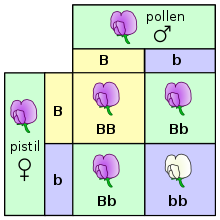
Back Fenotipe Afrikaans نمط ظاهري Arabic Fenotipu AST Fenotip Azerbaijani Фенотип Bulgarian Fenotip BS Fenotip Catalan ڕووخسارەبابەت CKB Fenotyp Czech Фенотип CV


In genetics, the phenotype (from Ancient Greek φαίνω (phaínō) 'to appear, show', and τύπος (túpos) 'mark, type') is the set of observable characteristics or traits of an organism.[1][2] The term covers the organism's morphology (physical form and structure), its developmental processes, its biochemical and physiological properties, its behavior, and the products of behavior. An organism's phenotype results from two basic factors: the expression of an organism's genetic code (its genotype) and the influence of environmental factors. Both factors may interact, further affecting the phenotype. When two or more clearly different phenotypes exist in the same population of a species, the species is called polymorphic. A well-documented example of polymorphism is Labrador Retriever coloring; while the coat color depends on many genes, it is clearly seen in the environment as yellow, black, and brown. Richard Dawkins in 1978[3] and then again in his 1982 book The Extended Phenotype suggested that one can regard bird nests and other built structures such as caddisfly larva cases and beaver dams as "extended phenotypes".
Wilhelm Johannsen proposed the genotype–phenotype distinction in 1911 to make clear the difference between an organism's hereditary material and what that hereditary material produces.[4][5] The distinction resembles that proposed by August Weismann (1834–1914), who distinguished between germ plasm (heredity) and somatic cells (the body). More recently, in The Selfish Gene (1976), Dawkins distinguished these concepts as replicators and vehicles.
- ^ "Phenotype adjective – Definition, pictures, pronunciation and usage notes". Oxford Advanced Learner's Dictionary at OxfordLearnersDictionaries.com. Retrieved 2020-04-29.
the set of observable characteristics of an individual resulting from the interaction of its genotype with the environment.
- ^ "Genotype versus phenotype". Understanding Evolution. Retrieved 2020-04-29.
An organism's genotype is the set of genes that it carries. An organism's phenotype is all of its observable characteristics — which are influenced both by its genotype and by the environment.
- ^ Cite error: The named reference
r1was invoked but never defined (see the help page). - ^ Churchill FB (1974). "William Johannsen and the genotype concept". Journal of the History of Biology. 7 (1): 5–30. doi:10.1007/BF00179291. PMID 11610096. S2CID 38649212.
- ^ Johannsen W (August 2014). "The genotype conception of heredity. 1911". International Journal of Epidemiology. 43 (4): 989–1000. doi:10.1086/279202. JSTOR 2455747. PMC 4258772. PMID 24691957.
© MMXXIII Rich X Search. We shall prevail. All rights reserved. Rich X Search